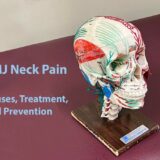Suicide Prevention and Awareness Provided by Pain Management

Suicide Prevention and Awareness Provided by Better Pain Management
More chronic pain providers are now better trained in managing the opioid crisis and cognitive behavioral therapy for suicide prevention (CBT-SP).
The Minnesota Head and Neck Pain Clinics provides multiple resources that assist pain clinicians and communities with information about the opioid crisis, addiction as a chronic disease, and evidence-based treatments.
Read the following articles for help to prevent suicide and lower your pain:
- Chronic Pain Providers’ Role in Curbing the Opioid Crisis
- How SSRIs can Trigger Teeth Grinding and Bruxism
- Trauma-Triggered Pain Management and Recovery
- Health Care and Addiction: Instead of Opioids, Prevent Chronic Pain
The approach we use to create broader support for pain patients for mental health and SUD treatment. Our ecosystem of pain recovery is a network of trained pain specialists that work together and use best practices to ensure effective treatment, care transitions, ongoing support, and sustained long-term recovery for people facing issues due to using of prescriptions and antidepressants.
Telehealth is an ideal way to get professional help from a remote provider. We use conservative methods of treatment first and cautiously prescribe maintenance medication for opioid use disorder (MOUD).
Chronic Pain Patients face Higher Risks of Addiction and Suicide
Pain is a complex phenomenon influenced by multiple factors, including biologic, psychological, and social factors=. This complexity means substantially integrated provider communications, flexibility, and knowledge is needed for the effectiveness of various pain treatments. It depends on the type of underlying pain or condition being treated, as well as the patient’s capacity to carry out effective self-care. Patients may experience persistent pain that is not well controlled. Chronic pain often co-occurs with behavioral health conditions, including mental and substance use disorders.
At each point of treatment, extra care is needed as patients with chronic pain also are at increased risk for suicidal ideation and behaviors.
“The range of therapeutic options has historically been inaccessible to many patients because of factors such as inadequate clinician education, training, and guidance; unconscious bias; a shortage of pain management specialists; insufficient access to treatment modalities such as behavioral therapy; siloed health systems; insurance coverage and reimbursement policies; and lack of clarity about the evidence supporting different pain treatments. Partly because of these factors affecting access to a wide range of treatment modalities, for many years medications such as prescription opioids have been the mainstay to treat pain, despite very limited evidence to support their long-term (more than 1 year) benefits; most placebo-controlled trials have been less than 6 weeks in duration.” – CDC Clinical Practice Guideline for Prescribing Opioids for Pain — United States, 2022 from the CDC
Implementation Considerations for Chronic Pain Providers
– To inform the patient of risks and provide safe, moderated care, first assess the person’s tolerance for prescription medications. Clinicians should remain open to providing patients from care even if they show a toxicology test result. Comprehensive and thoughtful healthcare always considers the adverse consequences if the patient is dismissed from a provider’s care. Patient safety and the risks of potentially tipping the patient over an edge to try to obtain opioids or other drugs from alternative sources must be taken into consideration.
– Before prescribing opioids as well as periodic checks during opioid therapy, clinicians who consider the benefits and risks of other prescription and nonprescription controlled substances are taking necessary precautions. Knowing the increased risk for overdose when combined with opioids, including nonprescribed and illicit opioids and benzodiazepines should be evaluated individually. They may be already taking other medications or have another medical condition that should be evaluated.
– Clinicians, pain clinic practices, health coaches, and health systems should aim to minimize bias in testing and should not apply this recommendation differentially on the basis of assumptions about patients.
Predicting risk requires in-depth evaluations, which is often challenging, and available tools do not allow clinicians to reliably identify patients who are at low risk for substance use or substance use disorders.
– Treatment care and pain managers should explain expected results (e.g., presence of prescribed medication and absence of drugs, including nonprescribed controlled substances not reported by the patient) and ask pain patients in a nonjudgmental way about the use of prescribed and other drugs and whether there might be unexpected results.
– Clinicians have the task of being familiar with available medication options. For example, a positive opiates immunoassay detects morphine, which might reflect a patient’s use of morphine, codeine, or heroin. However, it may miss detecting synthetic opioids and might not detect semisynthetic opioids. Helping the patient reduce stress through physical therapy and home exercises can make a significant difference.
How Chronic Pain Treatment Can Reduce Suicide Risk
NIH studies indicate that 50 percent of chronic pain patients consider suicide to escape their physical pain. This is a staggering statistic. Integrated treatments can help people choose life and gain a higher quality lifestyle. There are many good reasons for hope. Look past the bevy of pharmaceutical options available to target pain and accompanying depression; our pain specialists also offer self-help tools.
First, it is important that the cause of your pain is correctly identified. Different pain conditions require different treatments. For example, an orofacial pain specialist can help with pulled jaw muscles, TMD, neck pain, and related diagnosis.
How the Brain Responds to Pain
Chronic pain alters a person’s brain’s pain-processing functioning. It changes the brain structurally, functionally, and chemically, as well as impacts a person’s tolerance for ongoing pain. Structurally, researchers have discovered a decrease in the brain’s volume in a number of areas. One area consistently affected is the prefrontal cortex, the area in the front of our brains that are involved in attention, organization, and problem-solving.
Functionally, in chronic pain, the brain’s capacity to inhibit pain is lowered. There are chemical changes as well. Chronic pain patients have reduced levels of neurotransmitters – like, serotonin and norepinephrine, which help regulate both your mood and pain sensations.
Once we are able to address the roots of their secondary depression (when brought on by chronic pain), we can better establish a pain management plan. We may suggest a combination of deep breathing, mindfulness, putting support in place, and possible trigger point injections, which are effective at quieting pain. These techniques deliver a powerful message that patients have some options to ease their level of discomfort and can rely less on opioids and other antidepressants.
Strong Advocate for Suicide Prevention and Awareness
Call our experts if you are seeking the appropriate help tailored to your specific needs.
OUR MN LOCATIONS and PHONE NUMBERS:
Plymouth(763) 577-2484
St. Paul(651) 332-7474
Burnsville(952) 892-6222
St. Cloud(763) 233-7252


